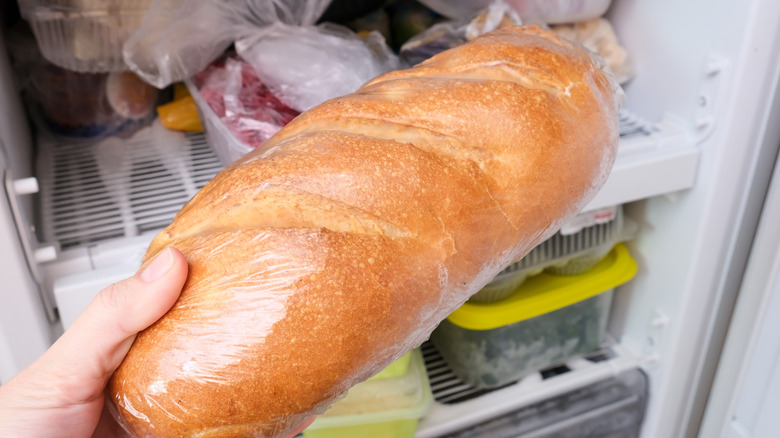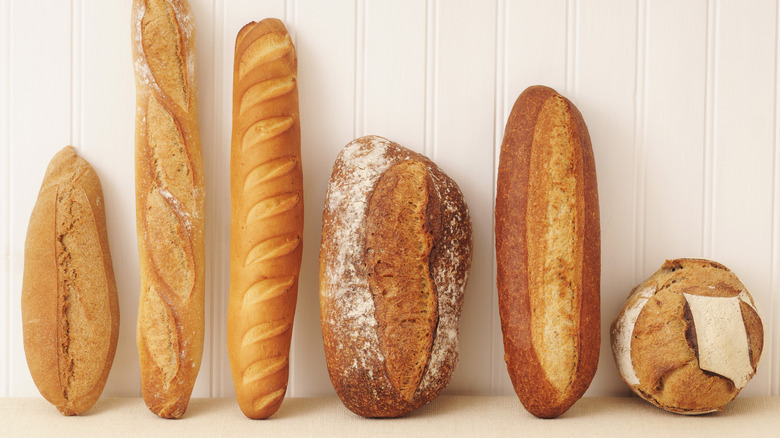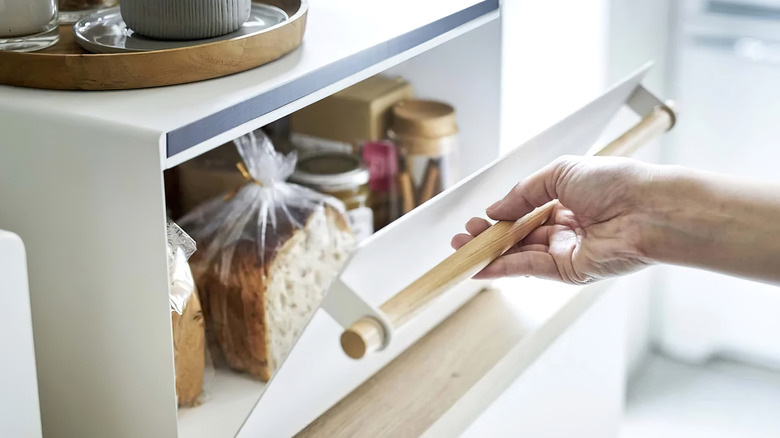Why The Fridge Should Be Your Last Choice For Storing Bread
Whether you're buying bread from a grocery store or bakery or making it yourself, the goal is to prevent that loaf from going stale for as long as it's around. Think the fridge makes everything last for longer? If you put bread in the refrigerator, you'll actually make it go stale a lot faster.
You might guess that this happens because the fridge is a dry environment. This is indeed part of the answer, but the staling process doesn't solely involve a loss of moisture. Bread goes stale when the water in its starch molecules migrates to the exterior of the loaf, causing them to recrystallize; this turns the structure of these molecules from pliable, relaxed, and squishy to hard and sharp. This phenomenon is called retrogradation, and though it will inevitably happen over time — no matter which conditions the bread is stored in — it happens faster at fridge-cold temperatures. (The freezer works better, though, because science is weird.)
If a recipe calls for stale bread — such as French toast, panzanella, or Jacques Pépin's savory pancakes – and you don't have any, you can stick a few slices in the fridge and use the rapid staling to your advantage. Otherwise, it's best to keep your bread at a warmer temperature.
What causes bread to go stale?
At its simplest, most breads are made of air, protein, and starch. The gluten (or the protein) in flour allows the bread to hold its structure around air pockets — that's how the crumb forms and how the bread rises. Meanwhile, starch molecules in the flour, like amylose and amylopectin, are crystalline; they have sharp edges and like to arrange themselves in an orderly fashion. Water softens these edges and disrupts their structure somewhat, essentially loosening them up. This is what makes fresh bread soft, springy, and pillowy.
As the bread sits around, water migrates away from these starch molecules and they once again turn crystalline and rigidly-organized. There we have it: starch retrogradation. This change is much faster in the refrigerator. A 2021 study published in the National Library of Medicine found that mixed sourdough bread kept in a plastic bag in the fridge became 68% more stale than an identical loaf left on the counter in a bag, while wheat bread in the fridge became 34% more stale than its room-temp counterpart.
This same study referenced another report which found that starches in "bread-like concentrations" undergo retrogradation between 23 degrees and 140 degrees Fahrenheit. This is why the freezer significantly slows staling, but the fridge doesn't. Unless you live in a sauna above 140 degrees, your loaves will still stale at room temp within a few days, but the bottom line is that cold (but not freezing) conditions speed things up.
How should you really store bread?
Bread is never as good as it is the day it was baked, but if you're not going to eat it all that day, there are a couple of ways to keep fresh for longer. Beyond the fridge, the 2021 study referenced above tested the staling of bread when kept in a plastic bag, bread box, or a plastic-coated and micro-perforated paper bag at room temperature. According to the results, keeping bread in a plastic bag at room temp during the first four days after baking slows down retrogradation most effectively.
Plastic bags work best for soft breads, as it creates an enclosed environment that will soften the crust and keep it moist. On the other hand, when storing homemade or store-bought crusty bread, a bread box might be a happy medium solution. The loaf will stale a bit faster, but its crust will stay crunchy instead of turning soft or leathery.
If you're not going to eat the whole loaf within a week, you'll want to consider freezing it. Most breads keep well in the freezer, so long as you stick them in there before they actually go stale, and defrosting it is as simple as toasting a slice or two, or letting the whole loaf come up to temperature on the table.


